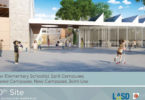The LASD board heard presentations from practitioners about school construction contract law and also about school construction financing practices at a board study session January 26, 2015. Attorney Mark Kelley of DWK – and education law firm – spoke for about 1 hour describing 5 main ways to structure construction contracts for spending the funds to be raised by the Los Altos School District Measure N bond. [5:00] The key contract tradeoffs were between cost and risk.
Dave Olsen, a school bond finance expert from The PFM Group spoke for about 30 minutes about approaches to the size and timing of bond issuance. He said our district’s situation was unusual. We don’t know if we are buying land or how much of the $150 million we need to do so. Thus we don’t know what size the first round of bonds issued should be. [Lalahpolitico hears it’ll be about $70 million for the site the board is rumored to be eyeing.] Private placement and short-term commericial borrowing for smaller amounts could be part of the mix.
Does Staff Prefer Non-competitive Contracting?
It is pretty clear during this meeting that staff — aka Superintendent Randy Kenyon — prefers a negotiated contract, probably a Lease Lease Back and probably one including Gelfand architects. Lisa Gelfand, who has been at almost EVERY board and committee meeting about Measure N, was apparently part of the 1999 “rescue team” than got the construction back on track after a disastrous one-year delay. In 2007-8 Kenyon also had a “good” experience using Lease Lease Back to execute the remodel and reopening of the Bullis-Purissima site in 2008. Taxpayers are still paying off the implicit long-term loan in that Bullis-Purissima contract. [Lalahpolitico expects some Measure N funds will be wisely used to pay that off in order to move to lower total interest costs.]
The public can expect to be “educated” about why Lease Lease Back is good for us.
Citizens Oversight Committee is Unimportant
Mark Kelley explained at some length how constrained [unimportant?] the role of the Measure N Citizens Oversight Committee (COC) is. [54:20]
A Committee that Actually Matters
Dave Kelley suggested that a board ad hoc committee containing two board members and some citizens and experts could be formed to seek and negotiate for land and to interview and negotiate with potential builders. This is a committee that would do something that matters. This committee would obviously not meet in public. And on Feb. 9, the board did just as Kelley suggested. It reconvened the ad hoc 10th Site Committee. Read about it here.
For Lalahpolitico, the most interesting section of the video was when the board explored the rocky history of the 1988-9 bond and construction experience for “lessons learned.” Starts at about 34:30.
Some suggested video jumping in time points
5:00 Mark Kelley begins the meat of his presentation – the board role and the 5 kinds of contracts…
34:30 Board members and staff review the rocky history of the 1998-9 LASD bond and construction experience for lessons learned
39:40 Mark Kelley seems to recommend the 10% to 15% more expensive negotiated Lease – Lease Back type of contract over a cheaper bur riskier “hard bid.”
54:20 Mark Kelley downplays the role of the Citizens Oversight Committee (recently formed by the board.) All they do is make sure the money was spent on “what’s allowable under the bond.” [not that it is well-spent, a good price, etc.]
58:23 The board may perhaps form an Ad Hoc Board Committee of 2 board members and a few real estate and construction experts
1:02:00 Mark Kelley explains that modern Lease Lease back contracts have a ballon payment 60 days after construction is complete, unlike the 1998 LLB contract that modernized Bullis Gardner in. That one is still being paid back over 20 years.
1:04:00 Superintendent for Business Randy Kenyon is planning another board presentation – this time on best practices for acquiring property.
1:17:00 Board trustee Sangeeth Peruri asks how much the public will ultimately pay for the borrowed $150 million. Dave Olsen estimates the public will pay a cumulative $340 million to borrow the $150 million.
1:30:30 A member of the public asks that if the board decides to use Lease Lease Back contracting, they do so as transparently as possible.






